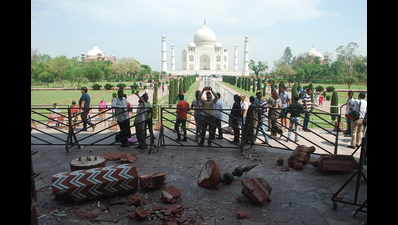Trending
This story is from April 12, 2018
Storm-hit Taj, Agra Fort, Fatehpur Sikri to be repaired at 'war footing': ASI
Winds with velocity of over 130 km per hour that swept Agra on Wednesday night caused considerable damage to the Taj Mahal, Agra Fort and Fatehpur Sikri. Besides the damages caused to the two minarets at royal and south gates of the Taj, other buildings within the 17th century mausoleum were also hit

Winds with velocity of over 130 km per hour that swept Agra on Wednesday night caused considerable damage to the Taj Mahal, Agra Fort and Fatehpur Sikri. Besides the damages caused to the two minarets at royal and south gates of the Taj, other buildings within the 17th century mausoleum were also hit
AGRA: Winds with velocity of over 130 km per hour that swept Agra on Wednesday night caused considerable damage to the Taj Mahal, Agra Fort and Fatehpur Sikri. Besides the damages caused to the two minarets at royal and south gates of the Taj, other buildings within the 17th century mausoleum were also hit. The pinnacle of a canopy at Shahi Masjid, a red sandstone flower vase at the tomb of Sirhindi Begum, and a portion of the wall of Rewti ka Bada, too, were damaged in the storm.
A ramp for handicapped tourists at the Taj’s royal gate was cracked after minarets fell on it.
At Agra Fort, besides the jolt to the minarets at the Delhi gate, several pinnacles at Moti Masjid and Musamman Burj got twisted due the high-velocity winds. Over 100 trees within the Taj and Agra Fort were also uprooted or partly damaged.
In Fatehpur Sikri, 8-10 marble pieces came off at Badshahi Darwaza and Buland Darwaza. A portion of the plaster work at Janana Rauza behind Sheikh Salim Chishti’s dargah was also damaged. A solar panel fell on the CCTV camera at Diwan-e-Aam, making it dysfunctional.
Talking to TOI, superintendent archaeologist, ASI (Agra circle), Bhuvan Vikram Singh said that the area where the damage occurred has been barricaded. He said the assessment work is going on and restoration will be undertaken after a report is received.
Refusing to disclose the estimated time needed for the restoration work and the cost involved, Singh said, “Once it begins, it will be done on a war footing.”
He, however, said public access to these areas will not be restricted during the restoration work. “The damage is confined only to the decorative parts and the structure has not be impacted in any manner,” he said.
Renowned historian Irfan Habib said he cannot recall any damage that had happened to Taj during a storm earlier. He said water leakage problems from the dome were reported in 1650 when it was still being built by Shahjahan. “Lightning conductors were installed to save the monument from natural lightning during the British period,” Habib said.
A ramp for handicapped tourists at the Taj’s royal gate was cracked after minarets fell on it.
At Agra Fort, besides the jolt to the minarets at the Delhi gate, several pinnacles at Moti Masjid and Musamman Burj got twisted due the high-velocity winds. Over 100 trees within the Taj and Agra Fort were also uprooted or partly damaged.
In Fatehpur Sikri, 8-10 marble pieces came off at Badshahi Darwaza and Buland Darwaza. A portion of the plaster work at Janana Rauza behind Sheikh Salim Chishti’s dargah was also damaged. A solar panel fell on the CCTV camera at Diwan-e-Aam, making it dysfunctional.
Archaeological Survey of India’s joint director general (conservation, world heritage) Janhwij Sharma visited the Taj Mahal on Thursday to assess the damage and plan restoration works.
Talking to TOI, superintendent archaeologist, ASI (Agra circle), Bhuvan Vikram Singh said that the area where the damage occurred has been barricaded. He said the assessment work is going on and restoration will be undertaken after a report is received.
Refusing to disclose the estimated time needed for the restoration work and the cost involved, Singh said, “Once it begins, it will be done on a war footing.”
He, however, said public access to these areas will not be restricted during the restoration work. “The damage is confined only to the decorative parts and the structure has not be impacted in any manner,” he said.
Renowned historian Irfan Habib said he cannot recall any damage that had happened to Taj during a storm earlier. He said water leakage problems from the dome were reported in 1650 when it was still being built by Shahjahan. “Lightning conductors were installed to save the monument from natural lightning during the British period,” Habib said.
End of Article
FOLLOW US ON SOCIAL MEDIA










